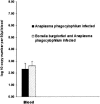Coinfection with Anaplasma phagocytophilum alters Borrelia burgdorferi population distribution in C3H/HeN mice
- PMID: 15908372
- PMCID: PMC1111882
- DOI: 10.1128/IAI.73.6.3440-3444.2005
Coinfection with Anaplasma phagocytophilum alters Borrelia burgdorferi population distribution in C3H/HeN mice
Abstract
Borrelia burgdorferi, the agent of Lyme disease, and Anaplasma phagocytophilum, the agent of human anaplasmosis, are both transmitted by Ixodes sp. ticks and may occasionally coinfect a host. The population distributions of tick-transmitted B. burgdorferi infection were assessed using quantitative PCR targeting the flaB gene of B. burgdorferi in the ear, heart base, quadriceps muscle, skin, and tibiotarsal joint tissue of C3H mice previously infected with A. phagocytophilum. Population distributions of Anaplasma infection were assessed by targeting the p44 gene. A. phagocytophilum in blood and serologic response to both agents were evaluated. Spirochete numbers were increased in the ears, heart base, and skin of coinfected mice, but Anaplasma numbers remained constant. Antibody response to A. phagocytophilum, but not B. burgdorferi, was decreased in coinfected mice. These results suggest that coinfection with A. phagocytophilum and B. burgdorferi modulates pathogen burden and host antibody responses. This may be explained by the ability of A. phagocytophilum to functionally impair neutrophils, important cells in the early defense against B. burgdorferi infection.
Figures


Similar articles
-
Serologic responses to peptides of Anaplasma phagocytophilum and Borrelia burgdorferi in dogs infested with wild-caught Ixodes scapularis.Vet J. 2017 Aug;226:6-11. doi: 10.1016/j.tvjl.2017.06.005. Epub 2017 Jun 27. Vet J. 2017. PMID: 28911844
-
Meta-analysis of coinfection and coexposure with Borrelia burgdorferi and Anaplasma phagocytophilum in humans, domestic animals, wildlife, and Ixodes ricinus-complex ticks.Vector Borne Zoonotic Dis. 2009 Feb;9(1):93-102. doi: 10.1089/vbz.2008.0072. Epub 2008 Sep 15. Vector Borne Zoonotic Dis. 2009. PMID: 18789001
-
Anaplasma phagocytophilum-infected neutrophils enhance transmigration of Borrelia burgdorferi across the human blood brain barrier in vitro.Int J Parasitol. 2006 May 1;36(5):601-5. doi: 10.1016/j.ijpara.2006.01.014. Epub 2006 Mar 6. Int J Parasitol. 2006. PMID: 16600247
-
Ecology of Anaplasma phagocytophilum and Borrelia burgdorferi in the western United States.J Vector Ecol. 2004 Jun;29(1):41-50. J Vector Ecol. 2004. PMID: 15266739 Review.
-
Global prevalence of Borrelia burgdorferi and Anaplasma phagocytophilum coinfection in wild and domesticated animals: A systematic review and meta-analysis.J Glob Health. 2024 Dec 6;14:04231. doi: 10.7189/jogh.14.04231. J Glob Health. 2024. PMID: 39641312 Free PMC article.
Cited by
-
Tick-borne pathogens in Finland: comparison of Ixodes ricinus and I. persulcatus in sympatric and parapatric areas.Parasit Vectors. 2018 Oct 24;11(1):556. doi: 10.1186/s13071-018-3131-y. Parasit Vectors. 2018. PMID: 30355331 Free PMC article.
-
Coinfections acquired from ixodes ticks.Clin Microbiol Rev. 2006 Oct;19(4):708-27. doi: 10.1128/CMR.00011-06. Clin Microbiol Rev. 2006. PMID: 17041141 Free PMC article. Review.
-
Infection dynamics of the tick-borne pathogen "Candidatus Neoehrlichia mikurensis" and coinfections with Borrelia afzelii in bank voles in Southern Sweden.Appl Environ Microbiol. 2014 Mar;80(5):1645-9. doi: 10.1128/AEM.03469-13. Epub 2013 Dec 27. Appl Environ Microbiol. 2014. PMID: 24375128 Free PMC article.
-
Differential Impact of Simultaneous or Sequential Coinfections With Borrelia afzelii and Tick-Borne Encephalitis Virus on the Ixodes ricinus Microbiota.Int J Microbiol. 2025 Jun 21;2025:7747795. doi: 10.1155/ijm/7747795. eCollection 2025. Int J Microbiol. 2025. PMID: 40585396 Free PMC article.
-
Tick-Borne Co-Infections: Challenges in Molecular and Serologic Diagnoses.Pathogens. 2023 Nov 20;12(11):1371. doi: 10.3390/pathogens12111371. Pathogens. 2023. PMID: 38003835 Free PMC article. Review.
References
-
- Belongia, E. A., K. D. Reed, P. D. Mitchell, P. H. Chyou, N. Mueller-Rizner, M. F. Finkel, and M. E. Schriefer. 1999. Clinical and epidemiological features of early Lyme disease and human granulocytic ehrlichiosis in Wisconsin. Clin. Infect. Dis. 29:1472-1477. - PubMed
-
- Belongia, E. A. 2002. Epidemiology and impact of coinfections acquired from Ixodes ticks. Vector Borne Zoonotic Dis. 2:265-273. - PubMed
-
- Cinco, M., D. Padovan, R. Murgia, M. Maroli, L. Frusteri, M. Heldtander, K. E. Johansson, and E. O. Engvall. 1997. Coexistence of Ehrlichia phagocytophila and Borrelia burgdorferi sensu lato in Ixodes ricinus ticks from Italy as determined by 16S rRNA gene sequencing. J. Clin. Microbiol. 35:3365-3366. - PMC - PubMed
Publication types
MeSH terms
Substances
Grants and funding
LinkOut - more resources
Full Text Sources
Medical

